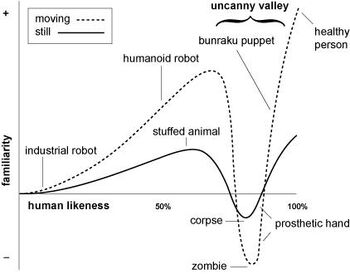
Masahiro’s graph depicting the relationship between human similarity and viewer response.
The Uncanny Valley is a hypothesis developed by Japanese roboticist Masahiro Mori in 1970. The hypothesis has great implications for the depiction of photorealistic humans in CGI. He postulated that as a robot becomes more human in appearance and motion, human beings will have an increasingly positive, empathic response. However, when some point of human-like quality is reached, the response will switch to repulsion and uneasiness. Eventually though, the response will become positive once again when the robot is almost entirely human.[1]
Scientific Investigation[]
This idea has met with some criticism that points to lack of proof as a basis for it being pseudoscience.[2] As recent as August 2007 though, several studies have been published that investigated the scientific and psychological basis for this hypothesis. These found through the survey of numerous participants, that there was in fact a point between artificial human depictions, such as dolls and CGI, and actual photographs of humans that evoked an increasingly unpleasant emotional response.[3] Interestingly though, the tests only detected the negative response when the figure had some abnormal feature, such as abnormal eye size or texture. So it is most likely that the Uncanny Valley is primarily prominent when an artist fails to depict all features in a near-human way. While the aspect of motion must still be studied, this gives some merit to the Uncanny Valley’s effect upon human depictions.
Psychology[]
Psychologists have suggested a few reasons for the Uncanny Valley, which also are strong reasons for the trouble CGI has with creating photorealistic humans. The most popular reason is based in the biology of social perception. Since human senses are well trained at reading moods from facial expressions and postures, these same senses create a super critical response to small flaws in representations of people. Similarly, little inaccuracies in the features of depictions of people blatantly stand out because we are so used to seeing accurate human faces in the physical world.[4] When a character is almost entirely human, the viewer sees a human figure and any deviations from what is expected stand out immediately. On the other hand, when a character is almost entirely non-human, the viewer sees a very different form and any human traits it has blatantly stand out. This same reason gives insight into why many production companies choose to use cartoony, anthropomorphic characters. Human sensitivity and empathy to the human form persuades us to create human traits in obviously non-human characters. But when we have to question whether something is authentically human or not, we scrutinize the image much more and compare it to the strong mental image we have of the human form.[5]
Further analysis of the uncanny reaction can be found in a 1906 article by Ernst Jentsch, “On the Psychology of the Uncanny,” which was later elaborated on by Sigmund Freud in “The Uncanny” (1919). In this essay Jentsch identifies one fairly regular cause for an uncanny feeling: uncertainty of whether a seemingly living entity is animate and uncertainty whether a lifeless object is not animate. Interestingly, Jentsch also notes that one of the most reliable devices for creating uncanny effects in stories is to leave the audience in doubt as to whether a character is a human person or an automaton.[6] The uncanny feelings associated with the Uncanny Valley may be caused by the inability to depict a character that is without a doubt animated and alive. Small abnormalities, such as the disproportioned eyes found in Seyama’s and Nagayama’s study, or inconsistent, artificial motion, are able to cause even the smallest amount of uncertainty about a character’s vitality. According to Jentsch, this doubt must be only felt obscurely by one’s conscious to have an uncanny effect. This would further explain why despite Final Fantasy: The Spirits Within's many realistic accuracies, such as motion and texture of hair, just a few abnormalities, like skin texture and body motion, create a strong uncanny effect.
References[]
- ↑ Template:Cite journal
- ↑ Ferber, Dan. “The Man Who Mistook His Girlfriend For A Robot.” Popular Science. Sept. 2003
- ↑ Seyama, J. and Nagayama, R. “The Uncanny Valley: Effect of Realism on the Impression of Artificial Human Faces.” Presence: Teleoperators and Virtual Environments 16.4 (2007):337-51
- ↑ Theodore, S. “Uncanny Valley.” Game Developer Dec. 2004: 43-5
- ↑ Bode, Lisa. “From Shadow Citizens to Teflon Stars: Reception of the Transfiguring Effects of New Moving Image Technologies.” Animation 1.2 (2006):173-89
- ↑ Jentsch, Ernst. “On the Psychology of the Uncanny (1906).” Angelaki: A New Journal in Philosophy, Literature, and the Social Sciences 2.1 (1995): 7-16
